Historic England: The endangered buildings saved from ruin
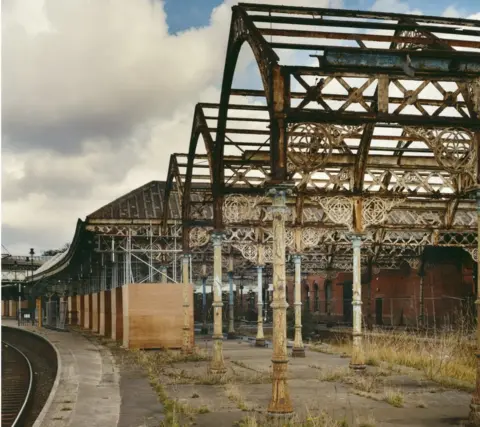 Historic England
Historic EnglandSince the heritage "at risk" register launched 20 years ago, more than two thirds of the original entries have been saved. But while hundreds are removed from Historic England's list each year, nearly as many are added. Which sites count as success stories - and which remain in danger?
The Midland Hotel, Morecambe
 Bob Skingle
Bob SkingleThe Midland Hotel opened on the seafront at Morecambe in 1933 and is believed to be the UK's first Art Deco hotel.
The London Midland and Scottish Railway spent the princely sum of £72,000 to build a hotel capable of coping with the booming number of tourists to the Lancashire resort.
Architect Oliver Hill was given the brief of "a building of international quality in the modern style". He came up with a three-storey, curved structure that allowed every room to have good sea views.
During its heyday, theatre stars performing at the nearby Winter Gardens, such as George Formby, Jimmy Clitheroe and Billy Bennett, were guests and parties were reputed to go on through the night.
 JB Helsby
JB HelsbyThe outbreak of World War Two gave the Midland a new role - as a military hospital. On the ground floor the dining room became a large ward with about 40 beds, while the circular café was adapted into a physiotherapy centre.
Two upstairs suites were turned into operating theatres and there were also X-ray facilities, a dental surgery and a dispensary.
After the war, the hotel changed hands a number of times, underwent unsympathetic refurbishment and fell victim to financial mismanagement.
It closed and fell into disrepair and was on the original at risk register in 1998. However, the redevelopment company Urban Splash spent £11m restoring its original features, including the grand staircase. It is now officially saved.
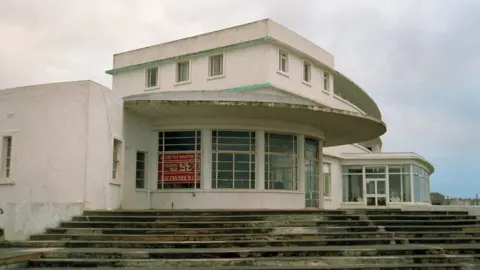 Heritage Images
Heritage ImagesTynemouth station, Tyne and Wear
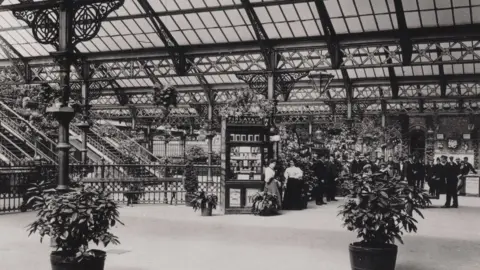 Station Developments Ltd
Station Developments LtdThe extravaganza of Victorian ironwork that is Tynemouth station, in Tyne and Wear, was opened in 1882. It was added to the register in 2004 and removed in 2012 after the owners and Historic England provided cash for its renovation.
Once decorated with a rich display of flora, the station was a destination in itself. However, the rise of the motorcar alongside more people going abroad on holiday contributed to its decline.
Although it has always remained a working station, the structure began to show a lack of care, as paint peeled from the metalwork and the glass canopies became dirty and cracked.
But a £3.68m restoration, which included fitting 4,600 new panes of glass, returned it to its former glory. A weekend market is now held on the station concourse and displays of artwork are regularly seen in the central section of the bridge and hanging from the roof area.
The station concourse is also used as an events area during the annual Mouth of the Tyne Festival.
The project won the Historic England Angel Award for Best Craftsmanship on a Heritage Rescue for 2012.
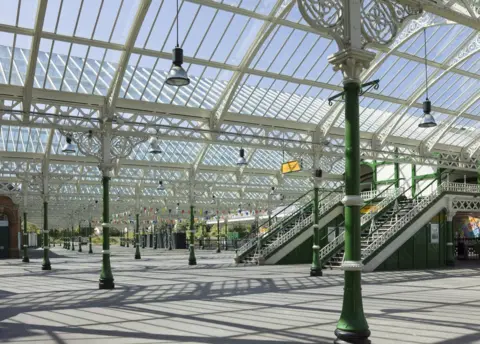 Historic England
Historic EnglandKirklees Priory Gatehouse, West Yorkshire
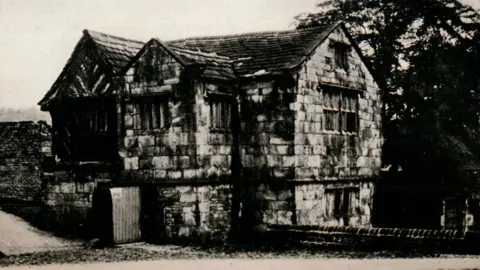 Getty Images
Getty ImagesThe timber-framed Kirklees Priory Gatehouse in Brighouse, West Yorkshire, had been on the register since 1998 but following repairs funded by Historic England, it was removed last year.
Although most of it was built in the early 16th Century, parts of its timber framing came from a medieval nunnery founded on the site during the reign of Henry II (1154-89).
A favourite haunt of Charlotte Brontë, it is also claimed to be where Robin Hood died.
Folklore suggests the prioress was his aunt and she sheltered him when he fled from the Sheriff of Nottingham. Another version of the story is that in old age Robin Hood fell ill and went to visit his cousin (rather than aunt) the prioress, so that he could be bled and restored to health.
However, his cousin conspired with her lover, Sir Roger of Doncaster, to kill Robin. So she opened a vein, locked Robin in the upper room of the gatehouse, and let him bleed to death. It's also said that he decided his own burial site by shooting an arrow from his deathbed in the gatehouse.
The arrow, somewhat implausibly, flew more than a mile. But still, that's where his grave is.
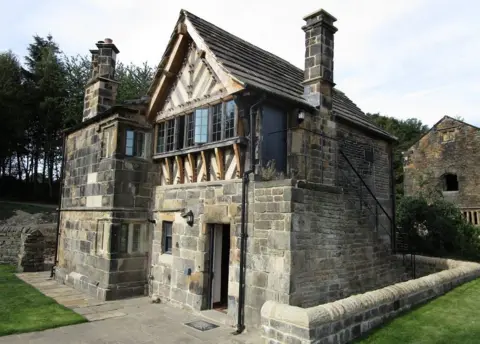 Historic England
Historic EnglandRoundhouse, Derby
 North Midland Railway
North Midland RailwayStrictly speaking, the Roundhouse in Derby is a hexadecagon, but we won't quibble. Built in 1839 by four rival rail companies, the huge 16-sided engine repair shed is known to be the earliest railway roundhouse in the world.
One of the companies that built it was the North Midland Railway, where George Stephenson and his son Robert were engineers.
Robert was the engineering brain behind the roundhouse, which was built for the sum of £62,000 and included a 12-metre engine turntable.
But the entire Derby Railway works complex became redundant and it was added to the at risk register in 1998, where it remained until 2009.
A project beginning in 2008 restored and updated the site. The original turntable has been kept in the renovated building as an example of manufacturing and railway heritage.
Both the roundhouse and the nearby engine sheds were converted into a venue for Derby College, and the space has been used for a variety of functions, including as a location for the TV programme Antiques Roadshow, the BBC Spending Review, and Ultra White-Collar Boxing. Sadly not all at the same time.
 The Roundhouse
The RoundhouseThe Kasbah, Grimsby
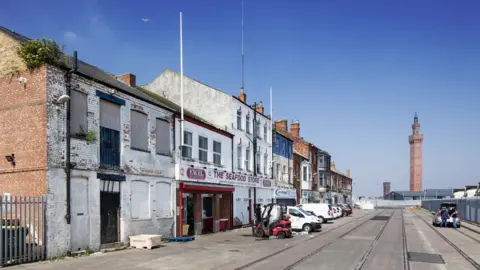 Alun Bull
Alun BullFor all the success stories, there are 5,160 entries on the 2018 at risk register. While that is 94 fewer than last year, there remains much to be done to preserve some of the country's historical sites.
Added to the latest at risk list is the Kasbah area in Grimsby, a year after it was designated a Conservation Area.
Grimsby was once home to the UK's largest fishing trawler fleet, but the fishing industry has been in decline for several decades. Most of the fish at the town's daily auction are now caught by crews from the Faroe Islands, Norway and Iceland.
You might also be interested in:
The town's "traditionally smoked fish" has been cured in the Kasbah smokehouses since the mid 19th Century, However, only a handful now exist in the area, which has become rundown.
Its owner, Associated British Ports, along with North East Lincolnshire Council and Historic England, are trying to attract funding for a repair programme.
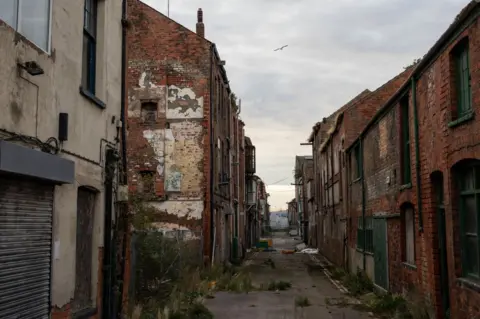 Dan Kitwood
Dan KitwoodHMS Invincible, off Portsmouth
 Bournemouth University
Bournemouth UniversityThe wreck of HMS Invincible lies on Horse and Dean Sand off Portsmouth. The wooden sailing vessel capsized while departing for Louisburg in Canada in 1758 and the wreck was discovered by a fisherman in 1979.
The ship was built in 1744 and captured from the French in 1747 at Cape Finisterre, whereupon it was taken into the Royal Navy. It was the first to bear the name Invincible.
Sandglasses, a bronze adze and cooper's setter used to open barrels, and cartridge cases have been recovered from the site as have army buttons from 13 different regiments. Some cannon lie 200 metres to the south, confirming that the quarterdeck cannon were jettisoned when the vessel got into difficulty.
Storms and shifting sands have left the site vulnerable to biological and physical decay. Historic England placed it on the risk register in 2012, and ongoing work to conserve and record the artefacts is being carried out by the Maritime Archaeology Sea Trust, along with Bournemouth University.
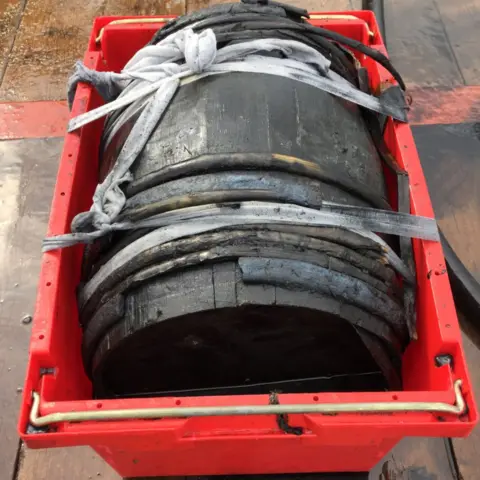 Mike Pitts
Mike PittsBattle of Newburn Ford, Newcastle upon Tyne
 Historic England
Historic EnglandKing Charles I's attempt to impose a new prayer book on the Scots led to military conflict in the summer of 1640, and the Battle of Newburn Ford, Newcastle upon Tyne, was the only battle of the Second Bishops' War.
The Scottish Army took Newcastle by defeating the English, forcing Charles I to pay them off.
This expense meant Charles had to recall Parliament, which proved to be a critical step towards the English Civil War.
The battlefield has been subject to piecemeal, peripheral development but an outline action plan has been agreed between Historic England, the local authorities and the Battlefields Trust.
The area is heavily industrialised, yet areas of historical and natural heritage interest are numerous. Standing at either end of Newburn Bridge provides a good view of the land over which the battle took place.
 Artist Peter Dunn
Artist Peter Dunn